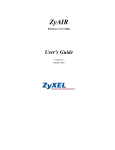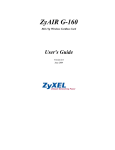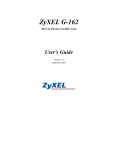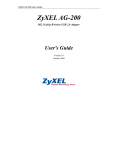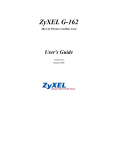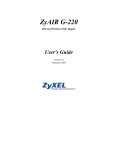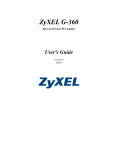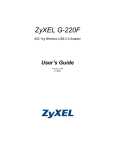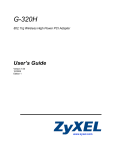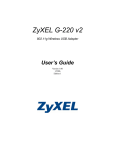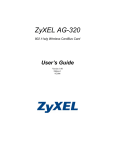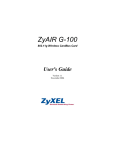Download ZyXEL Communications G-110 User`s guide
Transcript
ZyAIR G-110 802.11g Wireless CardBus Card User's Guide Version 1.10 May 2004 ZyAIR G-110 User’s Guide Copyright Copyright ©2004 by ZyXEL Communications Corporation The contents of this publication may not be reproduced in any part or as a whole, transcribed, stored in a retrieval system, translated into any language, or transmitted in any form or by any means, electronic, mechanical, magnetic, optical, chemical, photocopying, manual, or otherwise, without the prior written permission of ZyXEL Communications Corporation. Published by ZyXEL Communications Corporation. All rights reserved. Disclaimer ZyXEL does not assume any liability arising out of the application or use of any products, or software described herein. Neither does it convey any license under its patent rights nor the patents' rights of others. ZyXEL further reserves the right to make changes in any products described herein without notice. This publication is subject to change without notice. Trademarks Trademarks mentioned in this publication are used for identification purposes only and may be properties of their respective owners. ii Copyright ZyAIR G-110 User’s Guide ZyXEL Limited Warranty ZyXEL warrants to the original end user (purchaser) that this product is free from any defects in materials or workmanship for a period of up to two (2) years from the date of purchase. During the warranty period and upon proof of purchase, should the product have indications of failure due to faulty workmanship and/or materials, ZyXEL will, at its discretion, repair or replace the defective products or components without charge for either parts or labor and to whatever extent it shall deem necessary to restore the product or components to proper operating condition. Any replacement will consist of a new or re-manufactured functionally equivalent product of equal value, and will be solely at the discretion of ZyXEL. This warranty shall not apply if the product is modified, misused, tampered with, damaged by an act of God, or subjected to abnormal working conditions. NOTE Repair or replacement, as provided under this warranty, is the exclusive remedy of the purchaser. This warranty is in lieu of all other warranties, express or implied, including any implied warranty of merchantability or fitness for a particular use or purpose. ZyXEL shall in no event be held liable for indirect or consequential damages of any kind of character to the purchaser. To obtain the services of this warranty, contact ZyXEL's Service Center for your Return Material Authorization (RMA) number. Products must be returned Postage Prepaid. It is recommended that the unit be insured when shipped. Any returned products without proof of purchase or those with an out-dated warranty will be repaired or replaced (at the discretion of ZyXEL) and the customer will be billed for parts and labor. All repaired or replaced products will be shipped by ZyXEL to the corresponding return address, Postage Paid. This warranty gives you specific legal rights, and you may also have other rights that vary from country to country. Online Registration Register online at www.zyxel.com for free future product updates and information. ZyXEL Limited Warranty iii ZyAIR G-110 User’s Guide Information for Canadian Users The Industry Canada label identifies certified equipment. This certification means that the equipment meets certain telecommunications network protective operation and safety requirements. The Industry Canada does not guarantee that the equipment will operate to a user's satisfaction. Before installing this equipment, users should ensure that it is permissible to be connected to the facilities of the local telecommunications company. The equipment must also be installed using an acceptable method of connection. In some cases, the company's inside wiring associated with a single line individual service may be extended by means of a certified connector assembly. The customer should be aware that compliance with the above conditions may not prevent degradation of service in some situations. Repairs to certified equipment should be made by an authorized Canadian maintenance facility designated by the supplier. Any repairs or alterations made by the user to this equipment, or equipment malfunctions, may give the telecommunications company cause to request the user to disconnect the equipment. For their own protection, users should ensure that the electrical ground connections of the power utility, telephone lines, and internal metallic water pipe system, if present, are connected together. This precaution may be particularly important in rural areas. Caution Users should not attempt to make such connections themselves, but should contact the appropriate electrical inspection authority, or electrician, as appropriate. Note This digital apparatus does not exceed the Class B limits for radio noise emissions from digital apparatus set out in the radio interference regulations of Industry. iv Information for Canadian Users ZyAIR G-110 User’s Guide Federal Communications Commission (FCC) Interference Statement The device complies with Part 15 of FCC rules. Operation is subject to the following two conditions: • This device may not cause harmful interference. • This device must accept any interference received, including interference that may cause undesired operations. This equipment has been tested and found to comply with the limits for a Class B digital device pursuant to Part 15 of the FCC Rules. These limits are designed to provide reasonable protection against harmful interference in a commercial environment. This equipment generates, uses, and can radiate radio frequency energy, and if not installed and used in accordance with the instructions, may cause harmful interference to radio communications. If this equipment does cause harmful interference to radio/television reception, which can be determined by turning the equipment off and on, the user is encouraged to try to correct the interference by one or more of the following measures: 1. Reorient or relocate the receiving antenna. 2. Increase the separation between the equipment and the receiver. 3. Connect the equipment into an outlet on a circuit different from that to which the receiver is connected. 4. Consult the dealer or an experienced radio/TV technician for help. Notice 1 Changes or modifications not expressly approved by the party responsible for compliance could void the user's authority to operate the equipment. Caution 1. The equipment complies with FCC RF radiation exposure limits set forth for an uncontrolled environment, under 47 CFR 2.1093 paragraph (d) (2). 2. This Transmitter must not be co-located or operating in conjunction with any other antenna or transmitter This product has been designed for the WLAN 2.4 GHz network throughout the EC region and Switzerland, with restrictions in France. Certifications 1. Go to www.zyxel.com. 2. Select your product from the drop-down list box on the ZyXEL home page to go to that product's page. 3. Select the certification you wish to view from this page. FCC Statement v ZyAIR G-110 User’s Guide Customer Support When contacting your Customer Support Representative, please have the following information ready: Product model and serial number. Warranty Information. Date you received your product. Brief description of the problem and the steps you took to solve it. METHOD SUPPORT E-MAIL SALES E-MAIL TELEPHONE1 FAX 1 WEB SITE REGULAR MAIL FTP SITE LOCATION WORLDWIDE NORTH AMERICA GERMANY FRANCE [email protected] +886-3-578-3942 www.zyxel.com www.europe.zyxel.com ftp.zyxel.com [email protected] +886-3-578-2439 ftp.europe.zyxel.com +1-800-255-4101 www.us.zyxel.com [email protected] +1-714-632-0882 DENMARK NORWAY 1 ZyXEL Communications Inc. 1130 N. Miller St. Anaheim CA 92806-2001 U.S.A. [email protected] +1-714-632-0858 ftp.us.zyxel.com www.zyxel.de ZyXEL Deutschland GmbH. Adenauerstr. 20/A2 D-52146 Wuerselen Germany www.zyxel.fr ZyXEL France 1 rue des Vergers Bat. 1 / C 69760 Limonest France www.zyxel.es ZyXEL Communications Alejandro Villegas 33 1º, 28043 Madrid Spain www.zyxel.dk ZyXEL Communications A/S Columbusvej 5 2860 Soeborg Denmark www.zyxel.no ZyXEL Communications A/S Nils Hansens vei 13 0667 Oslo Norway [email protected] +49-2405-6909-0 [email protected] +49-2405-6909-99 [email protected] +33 (0)4 72 52 97 97 +33 (0)4 72 52 19 20 SPAIN ZyXEL Communications Corp. 6 Innovation Road II Science Park Hsinchu 300 Taiwan [email protected] +34 902 195 420 [email protected] +34 913 005 345 [email protected] +45 39 55 07 00 [email protected] +45 39 55 07 07 [email protected] +47 22 80 61 80 [email protected] +47 22 80 61 81 “+” is the (prefix) number you enter to make an international telephone call. Customer Support vii ZyAIR G-110 User’s Guide METHOD SUPPORT E-MAIL SALES E-MAIL TELEPHONE1 FAX 1 WEB SITE REGULAR MAIL FTP SITE LOCATION SWEDEN FINLAND viii [email protected] +46 31 744 7700 [email protected] +46 31 744 7701 [email protected] +358-9-4780-8411 www.zyxel.se ZyXEL Communications A/S Sjöporten 4, 41764 Göteborg Sweden www.zyxel.fi ZyXEL Communications Oy Malminkaari 10 00700 Helsinki Finland Information for Canadian Users ZyAIR G-110 User’s Guide Table of Contents Copyright .......................................................................................................................................................ii ZyXEL Limited Warranty ..........................................................................................................................iii Information for Canadian Users.................................................................................................................iv Federal Communications Commission (FCC) Interference Statement....................................................v Customer Support.......................................................................................................................................vii List of Figures...............................................................................................................................................xi List of Tables ...............................................................................................................................................xii Preface.........................................................................................................................................................xiii Chapter 1 Getting Started .........................................................................................................................1-1 1.1 About Your ZyAIR ........................................................................................................................1-1 1.2 ZyAIR Hardware and Utility Installation.....................................................................................1-1 1.3 Disable Windows XP Wireless LAN Configuration Tool .............................................................1-1 1.4 Accessing the ZyAIR Utility..........................................................................................................1-4 Chapter 2 Using the ZyAIR Utility...........................................................................................................2-1 2.1 About Wireless LAN Network.......................................................................................................2-1 2.1.1 Channel ................................................................................................................................2-1 2.1.2 SSID .....................................................................................................................................2-1 2.1.3 Transfer Rate........................................................................................................................2-1 2.2 Wireless Network Application......................................................................................................2-1 2.2.1 Ad-Hoc (IBSS).....................................................................................................................2-2 2.2.2 Infrastructure ........................................................................................................................2-2 2.3 Roaming .......................................................................................................................................2-3 2.4 Viewing Current Configuration ...................................................................................................2-4 2.4.1 Common Screen Command Buttons ....................................................................................2-6 2.5 Configuring the ZyAIR Wireless Parameters ...............................................................................2-6 2.6 Network Configuration Profile Setting.........................................................................................2-9 2.6.1 Saving the Current Setting to a Profile.................................................................................2-9 2.6.2 Using a Pre-configured Profile.............................................................................................2-9 2.6.3 Deleting a Profile ...............................................................................................................2-10 2.7 The Site Survey Screen ...............................................................................................................2-10 2.7.1 Connecting to a Network....................................................................................................2-11 2.8 About Wireless LAN Security .....................................................................................................2-11 2.8.1 Data Encryption with WEP ................................................................................................2-12 Table of Contents ix ZyAIR G-110 User’s Guide 2.8.2 Authentication Mode .........................................................................................................2-13 2.8.3 IEEE 802.1x.......................................................................................................................2-13 2.8.4 WPA ..................................................................................................................................2-13 2.8.5 WPA-PSK Application Example .......................................................................................2-14 2.8.6 WPA with RADIUS Application Example........................................................................2-15 2.9 Configuring Wireless Security on the ZyAIR .............................................................................2-16 2.9.1 WEP Encryption ................................................................................................................2-17 2.9.2 WPA-PSK..........................................................................................................................2-19 2.9.3 WPA ..................................................................................................................................2-20 2.9.4 IEEE802.1x........................................................................................................................2-22 2.10 The About Screen .......................................................................................................................2-24 Chapter 3 Maintenance .............................................................................................................................3-1 3.1 Uninstalling the ZyAIR Utility .....................................................................................................3-1 3.2 Upgrading the ZyAIR Utility........................................................................................................3-1 Chapter 4 Troubleshooting .......................................................................................................................4-1 4.1 Problems Starting the ZyAIR Utility Program.............................................................................4-1 4.2 Problems Communicating With Other Computers.......................................................................4-1 4.3 Problem with the Link Status .......................................................................................................4-2 Appendix A Types of EAP Authentication ................................................................................................ A Appendix B Product Specifications............................................................................................................ C Index ..............................................................................................................................................................F x Table of Contents ZyAIR G-110 User’s Guide List of Figures Figure 1-1 Windows XP: System Tray Icon.................................................................................................1-2 Figure 1-2 Windows XP: System Tray Icon.................................................................................................1-2 Figure 1-3 Windows XP: Wireless Network Connection Status ..................................................................1-2 Figure 1-4 Windows XP: Wireless Network Connection.............................................................................1-3 Figure 1-5 Windows XP: Wireless Network Connection Properties............................................................1-4 Figure 1-6 ZyAIR Utility: System Tray Icon ...............................................................................................1-4 Figure 2-1 Ad-hoc Network Example ..........................................................................................................2-2 Figure 2-2 BSS Example..............................................................................................................................2-2 Figure 2-3 Infrastructure Network Example ................................................................................................2-3 Figure 2-4 Roaming Example ......................................................................................................................2-4 Figure 2-5 ZyAIR Utility: Link Info ............................................................................................................2-5 Figure 2-6 ZyAIR Utility: Profile: Configuration........................................................................................2-7 Figure 2-7 Odyssey Client ...........................................................................................................................2-8 Figure 2-8 ZyAIR Utility: Profile ................................................................................................................2-9 Figure 2-9 Site Survey ...............................................................................................................................2-10 Figure 2-10 Wireless LAN Security Levels ...............................................................................................2-12 Figure 2-11 WPA - PSK Authentication.....................................................................................................2-15 Figure 2-12 WPA with RADIUS Application Example .............................................................................2-16 Figure 2-13 ZyAIR Utility: Security Configuration: None........................................................................2-17 Figure 2-14 ZyAIR Utility: Security Configuration: WEP ........................................................................2-18 Figure 2-15 ZyAIR Utility: Security Configuration: WPA-PSK ...............................................................2-20 Figure 2-16 ZyAIR Utility: Security Configuration: WPA ........................................................................2-21 Figure 2-17 ZyAIR Utility: Security Configuration: 802.1x......................................................................2-23 Figure 2-18 ZyAIR Utility: About .............................................................................................................2-25 List of Figures xi ZyAIR G-110 User’s Guide List of Tables Table 1-1 ZyAIR Utility: System Tray Icon ................................................................................................1-5 Table 2-1 ZyAIR Utility: Link Info .............................................................................................................2-5 Table 2-2 Common Screen Command Buttons............................................................................................2-6 Table 2-3 ZyAIR Utility: Profile: Configuration .........................................................................................2-7 Table 2-4 Site Survey.................................................................................................................................2-10 Table 2-5 ZyAIR Utility: Security Configuration: WEP ...........................................................................2-18 Table 2-6 ZyAIR Utility: Security Configuration: WPA-PSK...................................................................2-20 Table 2-7 ZyAIR Utility: Security Configuration: WPA ...........................................................................2-21 Table 2-8 ZyAIR Utility: Security Configuration: 802.1x.........................................................................2-23 Table 2-9 ZyAIR Utility: About.................................................................................................................2-25 Table 4-1 Troubleshooting Starting ZyAIR Utility Program .......................................................................4-1 Table 4-2 Troubleshooting Communication Problems ................................................................................4-1 Table 4-3 Troubleshooting Link Status ........................................................................................................4-2 xii List of Tables ZyAIR G-110 User’s Guide Preface Congratulations on the purchase of your new ZyAIR G-110 802.11g Wireless CardBus Card! About This User's Guide This guide provides information about the ZyAIR G-110 Wireless LAN Utility that you use to configure your ZyAIR G-110. Familiarize yourself with the Syntax Conventions listed below for better and faster understanding. Syntax Conventions • “Type” or “Enter” means for you to type one or more characters. "Select" or "Choose" means for you to use one of the predefined choices. • Mouse action sequences are denoted using a comma. For example, “click the Apple icon, Control Panels and then Modem” means first click the Apple icon, then point your mouse pointer to Control Panels and then click Modem. • Window and command choices are in Bold Times New Roman font. Predefined field choices are in Bold Arial font. • The ZyXEL ZyAIR G-110 802.11g Wireless CardBus Card is referred to as the ZyAIR in this guide. • The ZyAIR G-110 Wireless LAN Utility may be referred to as the ZyAIR Utility in this guide. Related Documentation Support Disk Refer to the included CD for support documents and device drivers. Quick Installation Guide Our Quick Installation Guide is designed to help you get your ZyAIR up and running right away. It contains a detailed easy-to-follow connection diagram and information on installing your ZyAIR. ZyXEL Glossary and Web Site Please refer to www.zyxel.com for an online glossary of networking terms and additional support documentation. User Guide Feedback Help us help you! E-mail all User’s Guide-related comments, questions or suggestions for improvement to [email protected] or send regular mail to The Technical Writing Team, ZyXEL Communications Corp., 6 Innovation Road II, Science-Based Industrial Park, Hsinchu, 300, Taiwan. Thank you! Preface xiii ZyAIR G-110 User’s Guide Graphics Icons Key Wireless Access Point Server Telephone xiv Computer Notebook computer Modem Wireless Signal Switch Router List of Tables ZyAIR G-110 User’s Guide Chapter 1 Getting Started This chapter prepares you to using the ZyAIR Utility. 1.1 About Your ZyAIR The ZyAIR is an IEEE 802.11g compliant wireless LAN PC card that fits into any 32-bit CardBus slot. With the ZyAIR, you can enjoy the wireless mobility within the coverage area. The IEEE 802.11g technology provides greater range and offers transmission rate at up to 54 Mbps. The following lists the main features of your ZyAIR. Your ZyAIR can communicate with other IEEE 802.11b/g/Wi-Fi compliant wireless devices. • Automatic rate selection. • Data transmission rates up to 54 Mbps. • Offers 64-bit and 128-bit WEP (Wired Equivalent Privacy) data encryption for network security. • Supports IEEE802.1x and WPA (Wi-Fi Protected Access). • Low CPU utilization allowing more computer system resources for other programs. • A built-in antenna and one external antenna connector (refer to the Quick Installation Guide). • Power and Link LEDs. • Driver support for Windows XP/2000/Me/98 SE. 1.2 ZyAIR Hardware and Utility Installation Follow the instructions in the Quick Installation Guide to install the ZyAIR Utility and driver and make hardware connections. 1.3 Disable Windows XP Wireless LAN Configuration Tool Windows XP includes a configuration tool for wireless LAN devices. DO NOT use the Windows XP configuration tool and the ZyAIR Utility at the same time. It is recommended you use the ZyAIR Utility to configure the ZyAIR. There are two methods to disable the configuration tool in Windows XP after you install the ZyAIR Utility. From ZyAIR Utility Right-click on the ZyAIR Utility system tray icon and click Turn off zero configuration. Getting Started 1-1 ZyAIR G-110 User’s Guide Figure 1-1 Windows XP: System Tray Icon From the Wireless Network Connection Status Screen Step 1. Double-click on the network icon for the wireless connection in the system tray. If the icon is not present, proceed to Step 2. Otherwise skip to Step 5. Figure 1-2 Windows XP: System Tray Icon Step 2. If the icon for the wireless network connection is not in the system tray, click Start, Control Panel and double-click on Network Connections. Step 3. Double-click on the icon for wireless network connection to display a status window as shown next. Figure 1-3 Windows XP: Wireless Network Connection Status Step 4. 1-2 Click Properties and click the Wireless Networks tab. Then skip to Step 6. Getting Started ZyAIR G-110 User’s Guide Step 5. When a Wireless Network Connection window displays, click Advanced…. Figure 1-4 Windows XP: Wireless Network Connection Getting Started 1-3 ZyAIR G-110 User’s Guide Step 6. In the Wireless Network Connection Properties window, make sure the Use Windows to configure my wireless network settings check box is not selected. Click OK. Figure 1-5 Windows XP: Wireless Network Connection Properties 1.4 Accessing the ZyAIR Utility After you installed the ZyAIR Utility, an icon for the ZyAIR Utility appears in the system tray. When the ZyAIR Utility system tray icon displays, the ZyAIR is installed properly. Figure 1-6 ZyAIR Utility: System Tray Icon The color of the ZyAIR Utility system tray icon indicates the status of the ZyAIR. Refer to the following table for details. 1-4 Getting Started ZyAIR G-110 User’s Guide Table 1-1 ZyAIR Utility: System Tray Icon COLOR DESCRIPTION Red The ZyAIR is not connected to a wireless network or is searching for an available wireless network. Green The ZyAIR is connected to a wireless network. Double click on the ZyAIR Utility icon in the system tray to open the ZyAIR Utility. Getting Started 1-5 ZyAIR G-110 User’s Guide Chapter 2 Using the ZyAIR Utility This chapter shows you how to configure the ZyAIR using the ZyAIR Utility. 2.1 About Wireless LAN Network This section describes each wireless LAN parameter. 2.1.1 Channel A channel is the radio frequency(ies) used by IEEE 802.11b wireless devices. The number of available channels depends on your geographical area. You may have a choice of channels (for your region) so adjacent APs (access points) should use different channels to reduce crosstalk. Crosstalk occurs when radio signals from different access points overlap causing interference and degrading performance. Adjacent channels partially overlap however. To avoid interference due to overlap, the AP should be on a channel at least five channels away from a channel that an adjacent AP is using. For example, if your region has 11 channels and an adjacent AP is using channel 1, then you need to select a channel between 6 or 11. 2.1.2 SSID The SSID (Service Set Identity) is a unique name shared among all wireless devices in a wireless network. Wireless devices must have the same SSID to communicate with each other. 2.1.3 Transfer Rate Your ZyAIR automatically adjusts the transmission rate to operate at the maximum transmission (data) rate. When the communication quality drops below a certain level, the ZyAIR automatically switches to a lower transmission (data) rate. Transmission at lower data speeds is usually more reliable. However, when the communication quality improves again, the ZyAIR gradually increases the transmission (data) rate again until it reaches the highest available transmission rate. 2.2 Wireless Network Application Wireless LAN works in either of the two modes: ad-hoc and infrastructure. To connect to a wired network within a coverage area using Access Points (APs), set the ZyAIR operation mode to Infrastructure (BSS). An AP acts as a bridge between the wireless stations and the wired network. In case you do not wish to connect to a wired network, but prefer to set up a small independent wireless workgroup without an AP, use the Ad-hoc (IBSS) (Independent Basic Service Set) mode. Using the ZyAIR Utility 2-1 ZyAIR G-110 User’s Guide 2.2.1 Ad-Hoc (IBSS) Ad-hoc mode does not require an AP or a wired network. Two or more wireless stations communicate directly to each other. An ad-hoc network may sometimes be referred to as an Independent Basic Service Set (IBSS). Figure 2-1 Ad-hoc Network Example To set up an ad-hoc network, configure all wireless stations in ad-hoc network type and use the same SSID and channel. 2.2.2 Infrastructure When a number of wireless stations are connected using a single AP, you have a Basic Service Set (BSS). Figure 2-2 BSS Example A series of overlapping BSS and a network medium, such as an Ethernet forms an Extended Service Set (ESS) or infrastructure network. All communication is done through the AP, which relays data packets to other wireless stations or devices connected to the wired network. Wireless stations can then access resource, such as the printer, on the wired network. 2-2 Using the ZyAIR Utility ZyAIR G-110 User’s Guide Figure 2-3 Infrastructure Network Example 2.3 Roaming Roaming in where in an infrastructure network, wireless stations are able to switch from one BSS to another as they move between coverage areas. During this period, the wireless station maintains uninterrupted connection to the network. As the wireless station moves from place to place, it is scans for the most appropriate AP depending on the signal strength, network utilization or other factors. The following figure depicts a roaming example. When Wireless Station B moves to position X, the ZyAIR in Wireless Station B automatically switches the channel to the one used by Access Point 2 in order to stay connected to the network. Using the ZyAIR Utility 2-3 ZyAIR G-110 User’s Guide Figure 2-4 Roaming Example 2.4 Viewing Current Configuration When the ZyAIR Utility starts, the Link Info screen displays first, showing the current configuration of your ZyAIR. 2-4 Using the ZyAIR Utility ZyAIR G-110 User’s Guide Figure 2-5 ZyAIR Utility: Link Info The following table describes the fields in this screen. Table 2-1 ZyAIR Utility: Link Info LABEL DESCRIPTION Current SSID This field displays the name of the wireless device/network to which the ZyAIR is associated. Link Status This field displays the current connection status of the ZyAIR. Re-Connect Click Re-Connect to have the ZyAIR search for and connect to a wireless device with the best signal reception. Settings Channel This field displays the radio channel the ZyAIR is currently using to connect to a wireless device. Security This field displays the wireless security mode you select in the Security Configuration screen. Using the ZyAIR Utility 2-5 ZyAIR G-110 User’s Guide Table 2-1 ZyAIR Utility: Link Info LABEL DESCRIPTION Transfer Rate This field displays the current transmission rate of the ZyAIR in megabits per second (Mbps). Current IP This field displays the current IP address of the ZyAIR. Operating Mode This field displays the network type (Infrastructure or Ad Hoc) of the ZyAIR. Tx/Rx (Total Frames) Transmitted Received This field displays the number of data frames transmitted. This field displays the number of data frames received. Signal Strength The status bar and the percentage number show the strength of the signal. Link Quality The status bar and the percentage number show the quality of the link. 2.4.1 Common Screen Command Buttons The following table describes common command buttons on all ZyAIR Utility screens. Table 2-2 Common Screen Command Buttons BUTTON DESCRIPTION OK Click OK to save all changes and close the ZyAIR Utility. Cancel Click Cancel to discard changes and close the ZyAIR Utility. Help Click Help to display the on-line help window. 2.5 Configuring the ZyAIR Wireless Parameters Click the Profile tab to display the screen as shown next. 2-6 Using the ZyAIR Utility ZyAIR G-110 User’s Guide Figure 2-6 ZyAIR Utility: Profile: Configuration Follow the instructions in the table below to configure the wireless LAN related fields. Refer to the next section for Profile field descriptions. Table 2-3 ZyAIR Utility: Profile: Configuration FIELD DESCRIPTION Configuration Server Set Enter the SSID (Service Set IDentifier) of the AP or the peer ad-hoc computer to which you want to associate in this field. To associate to an ad-hoc network, you must enter the same SSID as the peer ad-hoc computer. Enter any to associate to or roam between any infrastructure wireless networks. Operating Mode Select Infrastructure or Ad-Hoc from the drop-down list box. Select Infrastructure to associate to an AP. Select Ad-Hoc to associate to a peer ad-hoc computer. Refer to Section 2.2 for more information. Using the ZyAIR Utility 2-7 ZyAIR G-110 User’s Guide Table 2-3 ZyAIR Utility: Profile: Configuration FIELD DESCRIPTION Channel This field is activated if you select Ad-Hoc in the Operation Mode field. Select the channel number from the drop-down list box. To associate to a peer ad-hoc computer, you must use the same channel as the peer ad-hoc computer. Wireless Security Configuration Click Set Security to display the Security Configuration screen and configure the security settings for this profile. Undo Changes Click Undo Changes to start configuring the fields again. Apply Changes Click Apply Changes to save the changes back to ZyAIR. When you configure the ZyAIR to use a certificate in the Security Configuration screen and click Apply Changes in the Profile screen, the ZyAIR tries to connect to the network and a screen displays as shown. Figure 2-7 Odyssey Client To trust a server permanently, select Add this trusted server to the database and click Yes. 2-8 Using the ZyAIR Utility ZyAIR G-110 User’s Guide To trust a server for this session only, make sure the Add this trusted server to the database check box is not selected and click Yes. If you don’t want to trust an authentication server, click No. The ZyAIR will not connect to the network. 2.6 Network Configuration Profile Setting The Profile function in the Profile screen allows you to save the wireless network settings in the Profile screen or use one of the pre-configured network profiles. Figure 2-8 ZyAIR Utility: Profile 2.6.1 Saving the Current Setting to a Profile To save the current settings in the Profile screen to a new profile, enter a descriptive name in the Profile field and click Apply Changes. This also activates the new profile at the same time. 2.6.2 Using a Pre-configured Profile To use a previously saved network profile, select the profile file name from the drop-down list box. Using the ZyAIR Utility 2-9 ZyAIR G-110 User’s Guide Once you activate a profile, the ZyAIR Utility will use that profile the next time it is started. If you remove a profile, the ZyAIR Utility reverts to use the default profile. 2.6.3 Deleting a Profile To delete an existing wireless network configuration, select a profile from the drop-down list box and click Remove. 2.7 The Site Survey Screen Use the Site Survey screen to scan for and connect to a wireless network automatically. Figure 2-9 Site Survey The following table describes the fields in the table. Table 2-4 Site Survey FIELD ESSID 2-10 DESCRIPTION This field displays the SSID (or name) of each wireless device. Using the ZyAIR Utility ZyAIR G-110 User’s Guide Table 2-4 Site Survey FIELD DESCRIPTION Signal This field displays the signal strength of each wireless device in percentage. Channel This field displays the channel number used by each wireless device. Security This field shows whether the wireless security is activated (WEP, WPA-PSK, WPA or 802.1x) or inactive (None). BSS Type This field displays the wireless network type (Infra or Ad Hoc) of the wireless device. Infra denotes the infrastructure mode. Mode This field displays the wireless standard (802.11b or 802.11g) of the wireless device. BSSID This field displays the MAC address of the wireless device. Refresh Click Refresh to scan for available wireless device(s) within transmission range. Connect Click Connect to associate to the selected wireless device. 2.7.1 Connecting to a Network Follow the steps below to connect to a network using the Site Survey screen. Step 1. Click Search to scan for all available wireless networks within range. Step 2. To join a network, either click an entry in the table to select a wireless network and then click Connect or double-click an entry. Step 3. If the Security field is activated for the selected wireless network, you must also set the related fields in the Security Configuration screen to the same security settings. Refer to Section 2.9 for more information. Step 4. Verify that you have successfully connected to the selected network and check the network information in the Link Info screen. 2.8 About Wireless LAN Security Wireless LAN security is vital to your network to protect wireless communication between wireless stations and the wired network. The figure below shows the possible wireless security levels on your ZyAIR. EAP (Extensible Authentication Protocol) is used for authentication and utilizes dynamic WEP key exchange. It requires interaction with a RADIUS (Remote Authentication Dial-In User Service) server either on the WAN or your LAN to provide authentication service for wireless stations. Using the ZyAIR Utility 2-11 ZyAIR G-110 User’s Guide Figure 2-10 Wireless LAN Security Levels Configure the wireless LAN security using the Security Configuration screen. If you do not enable any wireless security on your ZyAIR, communication between the ZyAIR and the wired network is accessible to any wireless networking device that is in the coverage area. Make sure the security settings are the same on the ZyAIR and the intermediary AP and/or your network security server device. 2.8.1 Data Encryption with WEP WEP (Wired Equivalent Privacy) encryption scrambles all communication transmitted between the ZyAIR and the AP or other wireless stations to keep network communications private. Both the wireless stations and the access points must use the same WEP key for data encryption and decryption. There are two ways to create WEP keys in your ZyAIR. • Automatic WEP key generation based on a “password phrase” called a passphrase. The passphrase is case sensitive and only available when you select the HEX key type. You must use the same passphrase for all WLAN adapters with this feature in the same WLAN. For WLAN adapters without the passphrase feature, you can still take advantage of this feature by writing down the four automatically generated WEP keys from the Security Configuration screen of the ZyAIR Utility and entering them manually as the WEP keys in the other WLAN adapter(s). • Enter the WEP keys manually. Your ZyAIR allows you to configure up to four 64-bit or 128-bit WEP keys. You must enter four keys but only one key is used as the default key at any one time. 2-12 Using the ZyAIR Utility ZyAIR G-110 User’s Guide 2.8.2 Authentication Mode The IEEE 802.11b standard describes a simple authentication method between the wireless stations and AP. Two authentication modes are defined: Open and Shared. Open authentication mode is implemented for ease-of-use and when security is not an issue. The wireless station and the AP do not share a secret key. Thus the wireless stations can associate with any AP and listen to any data transmitted plaintext. Shared authentication mode involves a shared secret key to authenticate the wireless station to the AP. This requires you to enable WEP encryption and specify a WEP key on both the wireless station and the AP. 2.8.3 IEEE 802.1x The IEEE 802.1x standard outlines enhanced security methods for both the authentication of wireless stations and encryption key management. Authentication can be done using an external RADIUS server. EAP Authentication EAP (Extensible Authentication Protocol) is an authentication protocol that runs on top of the IEEE802.1x transport mechanism in order to support multiple types of user authentication. By using EAP to interact with an EAP-compatible RADIUS server, an access point helps a wireless station and a RADIUS server perform authentication. The type of authentication you use depends on the RADIUS server and an intermediary AP(s) that supports IEEE802.1x. The ZyAIR supports EAP-TLS, EAP-TTLS, EAP-PEAP and LEAP. Refer to the Types of EAP Authentication appendix for descriptions. For EAP-TLS and EAP-TTLS authentication types, you must first have a wired connection to the network and obtain the certificate(s) from a certificate authority (CA). A certificate (also called digital IDs) can be used to authenticate users and a CA issues certificates and guarantees the identity of each certificate owner. 2.8.4 WPA Wi-Fi Protected Access (WPA) is a subset of the IEEE 802.11i security specification draft. Key differences between WPA and WEP are user authentication and improved data encryption. User Authentication WPA applies IEEE 802.1x and Extensible Authentication Protocol (EAP) to authenticate wireless clients using an external RADIUS database. Therefore, if you don’t have an external RADIUS server you should use WPA-PSK (WPA -Pre-Shared Key) that only requires a single (identical) password entered into each access point, wireless gateway and wireless client. As long as the passwords match, a client will be granted access to a WLAN. Encryption WPA improves data encryption by using Temporal Key Integrity Protocol (TKIP), Message Integrity Check (MIC) and IEEE 802.1x. Using the ZyAIR Utility 2-13 ZyAIR G-110 User’s Guide Temporal Key Integrity Protocol (TKIP) uses 128-bit keys that are dynamically generated and distributed by the authentication server. It includes a per-packet key mixing function, a Message Integrity Check (MIC) named Michael, an extended initialization vector (IV) with sequencing rules, and a re-keying mechanism. TKIP regularly changes and rotates the encryption keys so that the same encryption key is never used twice. The RADIUS server distributes a Pairwise Master Key (PMK) key to the AP that then sets up a key hierarchy and management system, using the pair-wise key to dynamically generate unique data encryption keys to encrypt every data packet that is wirelessly communicated between the AP and the wireless clients. This all happens in the background automatically. The Message Integrity Check (MIC) is designed to prevent an attacker from capturing data packets, altering them and resending them. The MIC provides a strong mathematical function in which the receiver and the transmitter each compute and then compare the MIC. If they do not match, it is assumed that the data has been tampered with and the packet is dropped. By generating unique data encryption keys for every data packet and by creating an integrity checking mechanism (MIC), TKIP makes it much more difficult to decode data on a Wi-Fi network than WEP, making it difficult for an intruder to break into the network. The encryption mechanisms used for WPA and WPA-PSK are the same. The only difference between the two is that WPA-PSK uses a simple common password, instead of user-specific credentials. The commonpassword approach makes WPA-PSK susceptible to brute-force password-guessing attacks but it’s still an improvement over WEP as it employs an easier-to-use, consistent, single, alphanumeric password. 2.8.5 WPA-PSK Application Example A WPA-PSK application looks as follows. Step 1. First enter identical passwords into the AP and all wireless clients. The Pre-Shared Key (PSK) must consist of between 8 and 63 ASCII characters (including spaces and symbols). Step 2. The AP checks each client’s password and (only) allows it to join the network if it matches its password. Step 3. The AP derives and distributes keys to the wireless clients. Step 4. The AP and wireless clients use the TKIP encryption process to encrypt data exchanged between them. 2-14 Using the ZyAIR Utility ZyAIR G-110 User’s Guide Figure 2-11 WPA - PSK Authentication 2.8.6 WPA with RADIUS Application Example You need the IP address of the RADIUS server, its port number (default is 1812), and the RADIUS shared secret. A WPA application example with an external RADIUS server looks as follows. “A” is the RADIUS server. “DS” is the distribution system. Step 1. The AP passes the wireless client’s authentication request to the RADIUS server. Step 2. The RADIUS server then checks the user's identification against its database and grants or denies network access accordingly. Step 3. The RADIUS server distributes a Pairwise Master Key (PMK) key to the AP that then sets up a key hierarchy and management system, using the pair-wise key to dynamically generate unique data encryption keys to encrypt every data packet that is wirelessly communicated between the AP and the wireless clients. Using the ZyAIR Utility 2-15 ZyAIR G-110 User’s Guide Figure 2-12 WPA with RADIUS Application Example 2.9 Configuring Wireless Security on the ZyAIR In the Profile screen, click Set Security to display the Security Configuration screen as shown next. The screen varies depending on what you select in the Authentication field. You see the next screen when you select None in the Authentication field. 2-16 Using the ZyAIR Utility ZyAIR G-110 User’s Guide Figure 2-13 ZyAIR Utility: Security Configuration: None 2.9.1 WEP Encryption The WEP keys are used to encrypt communication before it is transmitted. The values for the keys must be set up exactly the same on the APs or other peer ad-hoc wireless computers as they are on the ZyAIR. Select WEP in the Authentication field to display the screen as shown next. Using the ZyAIR Utility 2-17 ZyAIR G-110 User’s Guide Figure 2-14 ZyAIR Utility: Security Configuration: WEP The following table describes the labels in this screen. Table 2-5 ZyAIR Utility: Security Configuration: WEP FIELD DESCRIPTION Authentication Select WEP from the drop down list. Encryption The WEP keys are used to encrypt data before it is transmitted. The values for the keys must be set up exactly the same on the APs or other peer ad-hoc wireless computers as they are on the ZyAIR. Select either 64-bit or 128-bit from the drop-down list box to activate WEP encryption and then fill in the related fields. Authentication Type Select Open System or Shared Key from the drop-down list box to authenticate the access point. Refer to Section 2.8.2 for more information. 2-18 Using the ZyAIR Utility ZyAIR G-110 User’s Guide Table 2-5 ZyAIR Utility: Security Configuration: WEP FIELD DESCRIPTION PassPhrase Enter the passphrase in the field provided. As you enter the passphrase, the ZyAIR automatically generates the WEP keys and displays them in the key fields below. Write down the automatically generated WEP keys in and use them to manually set the WEP keys in other WLAN adapters. Leave this field blank if you want to manually enter the WEP keys. The passphrase is case-sensitive and only available when you select the HEX key type. You must use the same passphrase for all wireless LAN adapters with this feature in the same WLAN. Key Type Select ASCII to enter WEP keys as ASCII characters. Select HEX to enter the WEP keys as hexadecimal characters. Transmit Key From the drop-down list menu, select a WEP key to use for data encryption. Key 1 … 4 Enter the WEP keys in the fields provided. If you select 64-bit in the Encryption field. Enter either 10 hexadecimal characters in the range of “A-F”, “a-f” and “0-9” (e.g. 11AA22BB33) for HEX key type or Enter 5 printable ASCII characters (case sensitive) ranging from “a-z”, “AZ” and “0-9” (e.g. MyKey) for ASCII key type. If you select 128-bit in the Encryption field, Enter either 26 hexadecimal characters in the range of “A-F”, “a-f” and “0-9” (for example, 00112233445566778899AABBCC) for HEX key type or Enter 13 printable ASCII characters (case sensitive) ranging from “a-z”, “AZ” and “0-9” (for example, MyKey12345678) for ASCII key type. The values for the keys must be set up exactly the same on all wireless devices in the same wireless LAN. ASCII WEP key is case sensitive. OK Click OK to save the changes. 2.9.2 WPA-PSK Select WPA-PSK in the Authentication field to display the screen as shown next. Using the ZyAIR Utility 2-19 ZyAIR G-110 User’s Guide Figure 2-15 ZyAIR Utility: Security Configuration: WPA-PSK The following table describes the labels in this screen. Table 2-6 ZyAIR Utility: Security Configuration: WPA-PSK FIELD DESCRIPTION Authentication Select WPA-PSK from the drop down list. Encryption Status WPA uses Temporal Key Integrity Protocol (TKIP) to improve data encryption. Passphrase The encryption mechanisms used for WPA and WPA-PSK are the same. The only difference between the two is that WPA-PSK uses a simple common password, instead of user-specific credentials. Type a passphrase from 8 to 63 case-sensitive ASCII characters (including spaces and symbols). OK Click OK to save the changes. 2.9.3 WPA Select WPA in the Authentication field to display the screen as shown next. 2-20 Using the ZyAIR Utility ZyAIR G-110 User’s Guide Figure 2-16 ZyAIR Utility: Security Configuration: WPA The following table describes the labels not previously discussed Table 2-7 ZyAIR Utility: Security Configuration: WPA FIELD DESCRIPTION Authentication Select WPA from the drop down list. Encryption Status WPA uses Temporal Key Integrity Protocol (TKIP) to improve data encryption. EAP Type Select an authentication method from the drop down list. Options are EAP-TLS, EAP-TTLS, EAP-PEAP and LEAP. Select LEAP if the (Cisco) AP you're connecting with uses LEAP to communicate with the RADIUS server. Login Name Enter a user name. This is the user name that you or an administrator set up on the RADIUS server. Password Enter the password associated with the user name above. This field is not available when you select EAP-TLS in the EAP Type field. Using the ZyAIR Utility 2-21 ZyAIR G-110 User’s Guide Table 2-7 ZyAIR Utility: Security Configuration: WPA FIELD Certificate DESCRIPTION This field is only available when you select EAP-TLS in the EAP Type field. You must first have a wired connection to a network and obtain the certificate(s) from a certificate authority (CA). Consult your network administrator for more information. Validate Server Certificate This field is not available when you select LEAP in the EAP Type field. Select the check box to check the certificate of the authentication server. TTLS Protocol This field is only available when you select EAP-TTLS in the EAP Type field. Use the drop down list box to select a TTLS protocol. Options are PAP, CHAP, MS CHAP and MS CHAP v2. PEAP Protocol This field is only available when you select EAP-PEAP in the EAP Type field. Use the drop down list box to select a PEAP protocol. Options are MD5 Challenge, EAP-GTC and MS CHAP v2. 2.9.4 IEEE802.1x The following sections describe how to configure IEEE802.1x security with various authentication methods. To set the IEEE802.1x WLAN security, select 802.1x in the Authentication field in the Security Configuration screen. 2-22 Using the ZyAIR Utility ZyAIR G-110 User’s Guide Figure 2-17 ZyAIR Utility: Security Configuration: 802.1x The following table describes the labels not previously discussed Table 2-8 ZyAIR Utility: Security Configuration: 802.1x FIELD DESCRIPTION Authentication Select 802.1x from the drop down list. EAP Type Select an authentication method from the drop down list. Options are EAP-TLS, EAP-TTLS, EAP-PEAP and LEAP. Select LEAP if the (Cisco) AP you're connecting with uses LEAP to communicate with the RADIUS server. Login Name Enter a user name. This is the user name that you or an administrator set up on the RADIUS server. Password Enter the password associated with the user name above. This field is not available when you select EAP-TLS in the EAP Type field. Using the ZyAIR Utility 2-23 ZyAIR G-110 User’s Guide Table 2-8 ZyAIR Utility: Security Configuration: 802.1x FIELD Certificate DESCRIPTION This field is only available when you select EAP-TLS in the EAP Type field. You must first have a wired connection to a network and obtain the certificate(s) from a certificate authority (CA). Consult your network administrator for more information. Validate Server Certificate This field is not available when you select LEAP in the EAP Type field. Select the check box to check the certificate of the authentication server. TTLS Protocol This field is only available when you select EAP-TTLS in the EAP Type field. Use the drop down list box to select a TTLS protocol. Options are PAP, CHAP, MS CHAP and MS CHAP v2. PEAP Protocol This field is only available when you select EAP-PEAP in the EAP Type field. Use the drop down list box to select a PEAP protocol. Options are MD5 Challenge, EAP-GTC and MS CHAP v2. 2.10 The About Screen The About screen displays related version numbers of the ZyAIR. 2-24 Using the ZyAIR Utility ZyAIR G-110 User’s Guide Figure 2-18 ZyAIR Utility: About The following table describes the read-only labels in this screen. Table 2-9 ZyAIR Utility: About FIELD DESCRIPTION Utility Version This field displays the version number of the ZyAIR Utility. Driver Version This field displays the version number of the ZyAIR Windows driver. Firmware Version This field displays the version of the firmware of the ZyAIR card. Using the ZyAIR Utility 2-25 ZyAIR G-110 User’s Guide Chapter 3 Maintenance This chapter describes how to uninstall or upgrade the ZyAIR Utility. 3.1 Uninstalling the ZyAIR Utility Follow the steps below to remove (or uninstall) the ZyAIR Utility from your computer. Step 1. Close and exit the ZyAIR Utility. Step 2. Click Start, (all) Programs, ZyAIR G-110 Wireless LAN PC Card, Uninstall. Step 3. When prompted, click OK to remove the driver and the utility software. Step 4. 3.2 Click Finish and restart the computer when prompted. Upgrading the ZyAIR Utility To perform the upgrade, follow the steps below. Step 1. Download the latest version of the utility from the ZyXEL web site and save the file on your computer. Step 2. Follow the steps in the Uninstalling the ZyAIR Utility section to remove the current ZyAIR Utility from your computer. Step 3. Restart the computer when prompted. Step 4. After restarting, refer to the procedure in the Quick Installation Guide to install the new utility software. Step 5. Check the version numbers in the About screen to make sure the new utility is installed properly. Maintenance 3-1 ZyAIR G-110 User’s Guide Chapter 4 Troubleshooting This chapter covers potential problems and the possible remedies. After each problem description, some instructions are provided to help you to diagnose and to solve the problem. 4.1 Problems Starting the ZyAIR Utility Program Table 4-1 Troubleshooting Starting ZyAIR Utility Program Cannot start the ZyAIR Wireless LAN Utility Make sure the ZyAIR is properly inserted and the LED is on. Refer to the Quick Installation Guide for the LED descriptions. Use the Device Manager to check for possible hardware conflicts. Click Start, Settings, Control Panel, System, Hardware and Device Manager. Verify the status of the ZyAIR under Network Adapter. (Steps may vary depending on the version of Windows). Install the ZyAIR in another computer. If the error persists, you may have a hardware problem. In this case, you should contact your local vendor. 4.2 Problems Communicating With Other Computers Table 4-2 Troubleshooting Communication Problems PROBLEM The ZyAIR computer cannot communicate with the other computer. A. Infrastructure Troubleshooting CORRECTIVE ACTION Make sure you are connected to the network. Make sure that the AP and the associated computers are turned on and working properly. Make sure the ZyAIR and the associated AP use the same SSID. Configure the AP to use another radio channel if interference is high. Make sure that the computer and the AP shares the same WEP key and authentication mode. Verify the settings in the Security Configuration screens. 4-1 ZyAIR G-110 User’s Guide Table 4-2 Troubleshooting Communication Problems PROBLEM B. 4.3 CORRECTIVE ACTION Ad-Hoc Verify that the peer computer(s) is turned on. Make sure the ZyAIR and the peer computer(s) are using the same SSID and channel. Use another radio channel if interference is high. Make sure that the ZyAIR and the AP share the same WEP key and authentication mode. Verify the settings in the Security Configuration screens. Problem with the Link Status Table 4-3 Troubleshooting Link Status PROBLEM CORRECTIVE ACTION The link quality and/or signal strength is poor all the time. Move your computer closer to the AP or the peer computer(s) within the transmission range. There is too much radio interference (for example microwave or another AP using the same channel) around your wireless network. Relocate or reduce the radio interference. The Site Survey screen displays all entries with low signal. Move your computer closer to the AP or peer computer(s) within the transmission range. There is too much radio interference (for example metal structure, microwave or another AP using the same channel) around your wireless network. Relocate or reduce the radio interference. 4-2 Troubleshooting ZyAIR G-110 User’s Guide Appendix A Types of EAP Authentication This appendix discusses the five popular EAP authentication types: EAP-MD5, EAP-TLS, EAP-TTLS, PEAP and LEAP. The type of authentication you use depends on the RADIUS server. Consult your network administrator for more information. EAP-MD5 (Message-Digest Algorithm 5) MD5 authentication is the simplest one-way authentication method. The authentication server sends a challenge to the wireless station. The wireless station ‘proves’ that it knows the password by encrypting the password with the challenge and sends back the information. Password is not sent in plain text. However, MD5 authentication has some weaknesses. Since the authentication server needs to get the plaintext passwords, the passwords must be stored. Thus someone other than the authentication server may access the password file. In addition, it is possible to impersonate an authentication server as MD5 authentication method does not perform mutual authentication. Finally, MD5 authentication method does not support data encryption with dynamic session key. You must configure WEP encryption keys for data encryption. EAP-TLS (Transport Layer Security) With EAP-TLS, digital certifications are needed by both the server and the wireless stations for mutual authentication. The server presents a certificate to the client. After validating the identity of the server, the client sends a different certificate to the server. The exchange of certificates is done in the open before a secured tunnel is created. This makes user identity vulnerable to passive attacks. A digital certificate is an electronic ID card that authenticates the sender’s identity. However, to implement EAP-TLS, you need a Certificate Authority (CA) to handle certificates, which imposes a management overhead. EAP-TTLS (Tunneled Transport Layer Service) EAP-TTLS is an extension of the EAP-TLS authentication that uses certificates for only the server-side authentications to establish a secure connection. Client authentication is then done by sending username and password through the secure connection, thus client identity is protected. For client authentication, EAP-TTLS supports EAP methods and legacy authentication methods such as PAP, CHAP, MS-CHAP and MS-CHAP v2. PEAP (Protected EAP) Like EAP-TTLS, server-side certificate authentication is used to establish a secure connection, then use simple username and password methods through the secured connection to authenticate the clients, thus hiding client identity. However, PEAP only supports EAP methods, such as EAP-MD5, EAP-MSCHAPv2 and EAP-GTC (EAP-Generic Token Card), for client authentication. EAP-GTC is implemented only by Cisco. Types of EAP Authentication A ZyAIR G-110 User’s Guide LEAP LEAP (Lightweight Extensible Authentication Protocol) is a Cisco implementation of IEEE802.1x. For added security, certificate-based authentications (EAP-TLS, EAP-TTLS and PEAP) use dynamic keys for data encryption. They are often deployed in corporate environments, but for public deployment, a simple user name and password pair is more practical. The following table is a comparison of the features of five authentication types. Comparison of EAP Authentication Types EAP-MD5 EAP-TLS EAP-TTLS PEAP LEAP No Yes Yes Yes Yes Certificate – Client No Yes Optional Optional No Certificate – Server No Yes Yes Yes No No Yes Yes Yes Yes Credential Integrity None Strong Strong Strong Moderate Deployment Difficulty Easy Hard Moderate Moderate Moderate No No Yes Yes No Mutual Authentication Dynamic Key Exchange Client Identity Protection B Types of EAP Authentication ZyAIR G-110 User’s Guide Appendix B Product Specifications PHYSICAL SPECIFICATIONS Product Name ZyAIR G-110 802.11g Wireless CardBus Card Type 3.3V 32-bit Cardbus card Standards IEEE 802.11b IEEE 802.11g Network Architectures Infrastructure Ad-Hoc Operating Frequencies 2.412-2.484GHz Operating Channels IEEE 802.11b: 11 Channels (North America) IEEE 802.11g: 11 Channels (North America) IEEE 802.11b: 13 Channels (Europe) IEEE 802.11g: 13 Channels (Europe) Data Rate IEEE 802.11b: 11, 5.5, 2, 1Mbps IEEE 802.11g: 54, 48, 36, 24, 18, 12, 9, 6 Mbps Modulation IEEE 802.11g: Orthogonal Frequency Division Multiplexing (64QAM, 16QAM, QPSK and BPSK) IEEE 802311b: Direct Spread Spectrum (CCK, DQPSK, DBOSK). Security 64/128-bit WEP Operating Temperature 0 ~ 50 degrees Centigrade Storage Temperature -30 ~ 60 degrees Centigrade Operating Humidity 10 ~ 90% (non-condensing) Storage Humidity 20 ~ 95% (non-condensing) Power Consumption TX: 471mA Voltage 3.3V±5% Weight 40g Dimension (W) 118mm × (D) 54mm × (H)7.5 mm Product Specifications RX: 422mA C ZyAIR G-110 User’s Guide RADIO SPECIFICATIONS Media Access Protocol IEEE 802.11 Frequency 2.4 ~ 2.4835GHz (Industrial Scientific Medical Band ) Channels 1~11 Channels (USA, Canada) 1~13 Channels (Europe) Data Rate 802.11g (OFDM): 6, 9, 12, 18, 24, 36, 48, 54 Mbps 802.11b: 1, 2, 5.5, 11 Mbps Modulation 802.11g: OFDM with BPSK, QPSK and 16/64-QAM sub-carrier modulations 802.11b: DBPSK, DQPSK, CCK Output Power 15 dBm (typical) at 11Mbps CCK 12 dBm (typical) at 54Mbps OFDM 802.11g (OFDM): RX Sensitivity 54 Mbps: -66 dBm 48 Mbps: -71 dBm 36 Mbps: -75 dBm 24 Mbps: -79 dBm 18 Mbps: -81 dBm 12 Mbps: -83 dBm 9 Mbps: -85 dBm 6 Mbps: -88 dBm 802.11b (CCK/DSS): 11 Mbps: -83 dBm 5.5 Mbps: -86 dBm 2 Mbps: -89 dBm 1 Mbps: -92 dBm SOFTWARE SPECIFICATIONS Device Drivers Microsoft Windows 98(SE), Windows 2000, Windows XP, Windows ME Roaming 802.11 compliant WEP Supports 64-bit and 128-bit encryption D Product Specifications ZyAIR G-110 User’s Guide ENVIRONMENTAL SPECIFICATIONS Temperature Operating: 0° ~ 50° C Storage: -30° ~ 60° C Relative Humidity 20% to 95% (non-condensing) Product Specifications E ZyAIR G-110 User’s Guide Index A About ............................................................ 2-24 Accessing the ZyAIR Utility .......................... 1-5 Authentication Mode .................................... 2-13 Open.......................................................... 2-13 Shared ....................................................... 2-13 Automatic WEP key generation.................... 2-12 B Basic Service Set ....................................See BSS BSS ................................................................. 2-2 C CA..................................................................... A Certificate Authority................................ See CA Channel........................................................... 2-8 Common Screen Command Buttons............... 2-6 Communication Problem ................................ 4-1 Ad-hoc(IBSS) ............................................. 4-2 Infrastructure............................................... 4-2 Connecting to a Network .............................. 2-11 Copyright ........................................................... ii Disclaimer...................................................... ii Trademarks .................................................... ii Create WEP key with passphrase ...2-19, 2-20, 221, 2-23 Customer Support ............................................ vii D Data encryption............................................. 2-12 Disable Windows XP Wireless Support ......... 1-1 E MD5.............................................................. A PEAP............................................................. A TLS ............................................................... A TTLS............................................................. A Encryption.....................................................2-14 ESS .................................................................2-3 Extended Service Set ..............................See ESS F Federal Communications Commission (FCC) Interference Statement ................................... v G Graphics Icons Key......................................... xiv I IBSS................................................................2-2 IEEE 802.11g..................................................1-1 Independent Basic Service Set.............. See IBSS Information for Canadian Users........................ iv Caution.......................................................... iv Note............................................................... iv Infrastructure...................................................2-2 L Link Info .........................................................2-4 M MD5.................................................................. A Message Digest Algorithm 5 ................ See MD5 Message Integrity Check...............................2-14 MIC........................ See Message Integrity Check EAP Authentication F Index ZyAIR G-110 User’s Guide N T Network Configuration Profile .......................2-9 Deleting.....................................................2-10 Saving .........................................................2-9 Using a pre-configured profile ..................2-10 Network Type .................................................2-2 Ad-Hoc(IBSS).............................................2-2 Infrastructure...............................................2-2 Online Registration ...........................................iii Open authentication mode.............................2-13 Operating Mode ..................... See Network Type Temporal Key Integrity Protocol ..................2-14 TKIP.......... See Temporal Key Integrity Protocol TLS ................................................................... A Transmission rate ............................................2-1 Transport Layer Security........................ See TLS Troubleshooting ..............................................4-1 Checking Hardware Conflict.......................4-1 Communication problems ...........................4-1 Radio interference .......................................4-2 Site Survery.................................................4-2 Starting ZyAIR Utility ................................4-1 TTLS ................................................................. A Tunneled Transport Layer Service .......See TTLS P U passphrase .....................................................2-12 PEAP................................................................. A Preface ............................................................xiii problem description.........................................4-1 Product specifications ....................................... C Profile..............................................................2-9 Network Configuration ...............................2-9 Protected EAP......................................See PEAP Upgrading the ZyAIR Utility ..........................3-1 User Authentication ......................................2-13 Using the ZyAIR Utility..................................2-1 O R Related Documentation...................................xiii Roaming..........................................................2-3 Example ......................................................2-4 S Service Set Identity ............................... See SSID Shared authentication mode ..........................2-13 Site Survey ....................................................2-10 SSID........................................................ 2-1, 2-7 Syntax Conventions ........................................xiii Index V Viewing Current Configuration ......................2-4 W Warranty............................................................iii Note...............................................................iii WEP ..............................................................2-12 WEP Data Encryption Configuring ...............................................2-16 WEP Data Encryption with ...........................2-12 WEP Key.......................................................2-12 Wired Equivalent Privacy ..................... See WEP Wireless LAN Parameters Channel .......................................................2-1 Configuring .................................................2-6 Network Type..............................................2-2 SSID ............................................................2-1 Transmission Rate.......................................2-1 G ZyAIR G-110 User’s Guide Wireless LAN Security Data Encryption with WEP....................... 2-12 WPA ............................................................. 2-13 WPA with RADIUS Application.................. 2-15 WPA-PSK..................................................... 2-13 WPA-PSK Application ................................. 2-14 Z ZyAIR Utility ................................................. 3-1 H About ........................................................2-25 Before you upgrade.....................................3-1 Link Info .....................................................2-5 Removing....................................................3-1 Site Survey................................................2-10 Upgrading ...................................................3-1 WEP Encryption .2-16, 2-17, 2-18, 2-20, 2-21, 2-23 ZyAIR Utility system tray icon.......................1-6 Index



























































